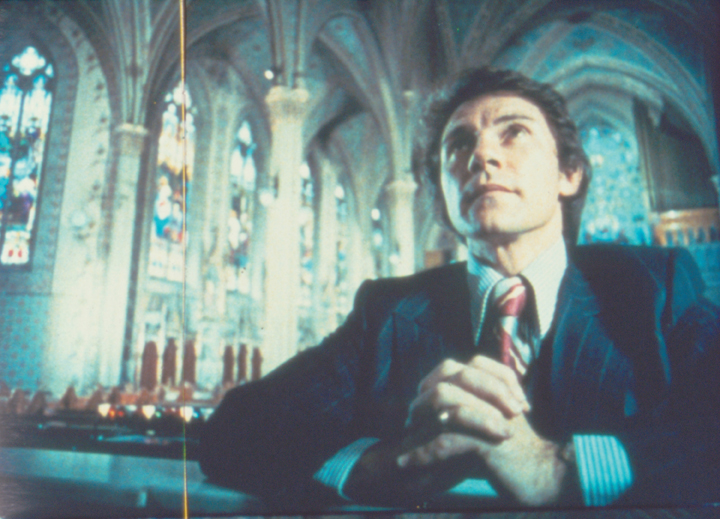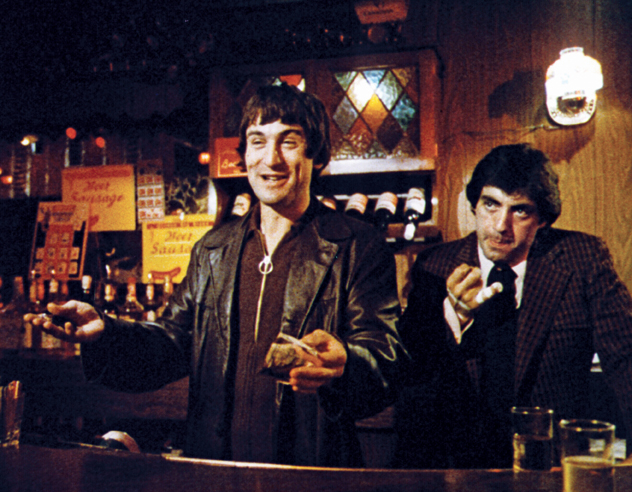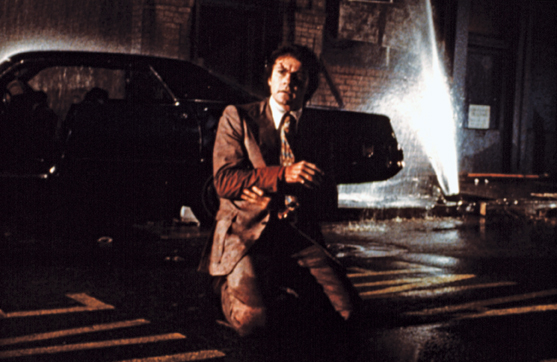BY AMY DAWES
 HOME TURF: Antoine Fuqua has tried
HOME TURF: Antoine Fuqua has tried
to apply the lessons he's learned
from Mean Streets to his own work.
"Look at these guys—it's a comedy routine! It's like, 'who's on first,' exclaims Antoine Fuqua as he watches a very young Harvey Keitel and Robert De Niro verbally sparring in a bar in an early scene from Martin Scorsese's 1973 breakout film,
Mean Streets.
"The first time I saw this scene I was laughing so hard I had tears in my eyes," says Fuqua as he revisits the movie in a DGA screening room. "Scorsese has such a sense of humor. It's always light until it's not. You can tell he grew up with these people, and I grew up with these same kinds of guys."
The influence of Scorsese and Mean Streets is much on Fuqua's mind as he finishes his new movie, Brooklyn's Finest, a cops and crooks saga that marks the director's return to the urban landscape of Training Day, the 2001 film that put him on the map (and won an Oscar for Denzel Washington). Fuqua has chosen to discuss Mean Streets because he says it was Scorsese's early work that helped him find his own voice as a director.
"I grew up in the projects in Pittsburgh," says Fuqua. "I didn't go to film school, so while I was working as a PA in the early '90s, someone suggested that I do my homework by researching the directors I admired." He watched Mean Streets and remembers, "It blew me away because it felt so real. I understood this world, and I thought, 'This is what I should be doing, in my own way.'"
Most of all, Fuqua relates to the struggle of Keitel's character, Charlie, to reconcile his Roman Catholic faith and need for spiritual meaning with the corrupt world he inhabits. ("I've never told anyone this, but when I did Training Day, in my mind, Ethan Hawke's character was Jesus and Denzel Washington was the Devil," Fuqua confesses.) Before the movie starts, Fuqua quotes its opening lines: "You don't make up for your sins in church. You do it in the streets."
 Charlie looking for salvation.
Charlie looking for salvation.
The first thing we see is Charlie waking up, and immediately, the sounds of city traffic can be heard in his room. Fuqua points out how deftly Scorsese introduces Charlie's world and its themes. "It almost looks like a confession," he notes as Charlie walks over to a mirror, wearing an undershirt and a crucifix. "The crosses on the wall, the cross around his neck—he's looking in the mirror, questioning himself."
As The Ronettes' "Be My Baby" blares, the title sequence rolls. "No one uses music like Scorsese," notes Fuqua, and indeed, Scorsese has said he used records from his own collection, pops and hisses intact, in an effort to set the soundtrack apart from what was then conventional. A movie projector screens grainy 16 mm footage of Charlie posing with guys from the neighborhood, then with a priest, then with his girlfriend, sharing communion cake. "He must have shot this with a Bolex," suggests Fuqua, referring to the ubiquitous student camera of a bygone era. "You get a sense of this world so quickly, before the story even starts."
Fuqua sees the documentary style in Mean Streets that Scorsese absorbed in his studies at NYU, particularly in his use of natural light. While the bar scenes were shot on a stage in L.A., a week of New York shooting took place in the actual streets and apartment buildings Scorsese grew up in.
Notably, the film incorporates footage from the annual Feast of San Gennaro in the streets of Little Italy. Scorsese had to pay the Feast committee for permission to shoot—money he borrowed from his friend Francis Coppola, whose film The Godfather was released the year before. "This is the street version of The Godfather," says Fuqua. "This world is ugly and shabby."
"Right away it's violent and crazy," laughs Fuqua, as we're thrust into the lights and music of the street festival, and then into a scene that was shocking for its time—a junkie shooting up in the bathroom of a bar, as the owner throws him out on his ear.
 Johnny Boy's unpredictability allows Scorsese to build dramatic tension.
Johnny Boy's unpredictability allows Scorsese to build dramatic tension.
He can go from cocky and funny in the bar to dangerous and
vulnerable, waving his gun around on the roof.
After Charlie is shown kneeling in church before an unseen priest (voiced by Scorsese), the film cuts to the netherworld of the bar. "He goes from this beautiful church to hell," says Fuqua. "Red lights, the strippers dancing on stage. He's showing Charlie's character immediately conflicted."
Fuqua points out how the dimly lit scene is shot through a red lens and a smoky haze, as a wide-angle dolly shot floats in slow motion across the faces of the denizens of the lower depths. "All the demons are at the bar," says Fuqua.
Into this den of iniquity comes Johnny Boy (De Niro) making his entrance, memorably, minus his pants (he's taken them off to amuse the girls he's with). The young De Niro, whippet-thin and clown-like in a porkpie hat, attempts to check his trousers along with the girls' coats. "He's got no pants on 'cause this world is fucking crazy, there's no rhyme or reason," observes Fuqua. "But the character brings all this humor, all this life to the story."
In a scene that Scorsese says De Niro improvised, Johnny Boy goes into a long song and dance for Charlie about why he doesn't have the money to pay back the loan he borrowed from Michael (Richard Romanus), the local loan shark. Fuqua notes Cassavetes' influence on the style of the dialogue, and how it adds realism and humor. "Everything you need to know about this guy you're getting right here—he's a lunatic and a liar. This character keeps the dramatic tension churning because all you need is one or two wild guys in a room, and anything can happen."
As the guys leave the bar and head out on a numbers-running errand, the camera pans from a statue of Jesus on top of a building down to their long, black car sliding through an alley. "He must have stolen that shot from a rooftop," observes Fuqua. "I doubt he had any money for a crane." As the car idles at a stoplight, a bearded bum wipes the windshield. Fuqua laughs, commenting on the realism and sense of immersion in Scorsese's way of working. "Look at the details he captures," Fuqua says. "They don't get rid of this old guy but here's the payoff—they're not going to tip him, either. They just drive away. There are so many stories going on within the larger story.
Later, in an erotic hotel room tryst between Charlie and his girlfriend Teresa (Amy Robinson), Fuqua points out the influence of other directors on the film-savvy Scorsese. He sees the playfulness of Godard's Breathless, Truffaut's intimacy, and again, the contentious energy of Cassavetes as the lovers bicker.
When Charlie arrives at a restaurant to meet with his uncle, a suave Mafia capo, he passes a wall adorned with pictures of Bobby and John Kennedy and the Pope. On the opposite side of the doorway is an image of Christ on the cross. Fuqua loves the contrast implied between the pious images and Charlie's uncle, sitting with his underworld cronies, all visible in the same frame. "The wall makes a dividing line between Jesus and the uncle. I never noticed that until just now," says Fuqua, amazed that, after all this time, he's still discovering new things in the film.
Unable to cut himself off from Johnny Boy, as his uncle advises, Charlie just feels more responsible as his friend gets deeper in debt. The loan shark warns Charlie that come payday, if Johnny Boy doesn't show up with the money, "I'm gonna find him, and I'm gonna break his fucking legs."
Scorsese sits on the story's underlying tension and allows it to percolate. Meanwhile, Charlie blows off steam by getting blasted at a party for a buddy returning from Vietnam. "This was experimental for those times," says Fuqua as he watches Charlie seem to float boozily through the scene. "He's on a crane arm, where the cameraman would usually sit, but they've turned the camera around on him. This is low-tech stuff, but it's unique and expressive. As much as you can be in this world, Scorsese puts you there." (It's this sequence that likely prompted critic Pauline Kael to call Scorsese's camerawork "dizzyingly sensual.")
After the decorated vet attempts a drunken assault on a dancer, Charlie drags the girl to semi-safety in a backroom, only to get an urgent knock on the door. Teresa is hysterical. "Johnny's been on the roof for half an hour and he's got a gun." "Don't get excited," says Keitel, his knee-jerk response so off the mark, it's almost comical.
For Fuqua, the banging on the door touches off a memory from his high school days when he and his friend danced with some older girls at a club and their boyfriends came to school hunting for his buddy and stabbed him in the bathroom. "You hear a knock like that," says Fuqua, rapping on the table, "and you wonder if everybody's in the house where they're supposed to be, or if someone's laid out in an alley. There's never a moment of peace in that life. Anything can happen. And that's what Scorsese conveys so well."
Shifting his attention back to the screen, Fuqua anticipates one of his favorite scenes. Up on the roof, waving his gun around, Johnny Boy says, "Watch this, I'm gonna shoot the light out on the Empire State Building." After Charlie coaxes the gun out of his hand, they cut through a cemetery where Johnny Boy lies on a gravestone as they argue about what to do next. "This is the brilliance of Scorsese to me," says Fuqua. "He puts the scene in a graveyard. It's what you cut through on your way home, but it also means something here."
Things continue to spin out of control, which, as Fuqua points out, Scorsese communicates with jagged, handheld camerawork following Johnny Boy as he moves crazily through streets, assaulting anyone who gets in his way. "He's gone wild, he's like a mad dog," notes Fuqua, "And it's expressed in the way this is shot. He's not worried about lighting it or anything."
When Johnny Boy finally shows up at the bar, he has only 10 bucks to give to Michael the loan shark. Michael balls it up and throws it at him. "You too good for this 10 dollars?" says Johnny Boy, electric with bravado, as he lights the 10-dollar bill on fire. Michael leaps across the bar to strangle him, and Johnny Boy makes the biggest mistake of his life—he pulls a gun. He backs off but it's too late.
"This is an important part of the movie," says Fuqua. "You can fight on the streets, you can argue, but you pull a gun on somebody and don't use it, you're a dead man. It's the worst thing you can do."
Charlie borrows a car so he can drive his friend some place to hide. In the midst of this building drama, Fuqua marvels at how Scorsese can still inject some humor in one of the film's most memorable moments. As Charlie starts up the car, the soundtrack erupts with "Mickey's Monkey" by The Miracles. De Niro, a cigarette pursed in his lips, dances playfully around the car. It's his charm and craziness in a nutshell. "He keeps the dramatic tension churning throughout the film because he'll do anything. He's completely unpredictable," explains Fuqua.
Teresa joins them and they drive across the bridge into Brooklyn. Again, the music is giddy, the scene turns almost joyful as they bicker about a plan, a counterpoint to what's really going on and about to happen. Then, in a flash, Michael roars up next to them in his big car, and a gunman opens fire from the backseat (the long-haired shooter is Scorsese, in a cameo).
"And that's how it happens. Suddenly, out of nowhere. It's so real. Scorsese really captures it," says Fuqua, perhaps thinking about instances of violence he's witnessed firsthand. "You don't know if they're shot or not, and then there's blood everywhere."
Hit in the neck, Johnny Boy screams and writhes, nearly climbing out the window of the swerving car. It crashes, and a hydrant spews a white geyser into the suddenly silent night. "It's actually beautiful the way Scorsese shot it," says Fuqua admiringly. "No witnesses are around. The streets are empty."
 Charlie can't protect Johnny Boy after he pulls a gun on the local loan shark.
Charlie can't protect Johnny Boy after he pulls a gun on the local loan shark.
As Johnny staggers down an alley—"bleeding out," as Fuqua puts it—the soundtrack returns to the Old World music from the festival, and the camera cuts to a tenement window, where a neighbor lowers the blinds on the night.
"I forgot that it ended with the shade going down. It's so real but it's also cinematic," remarks Fuqua. "It has the quality of capturing real life and magnifying it to make it so haunting."
As the credits roll and the lights come up, Fuqua reveals why he has taken even greater pleasure in rewatching the film. Since 2003, when Scorsese asked him to direct a concert film he produced to go with the 2003 PBS documentary The Blues, Fuqua has struck up a friendship with the director. "Watching this again, I see a lot of him in it. You hear it in the dialogue, in his love for cinema, the way the characters keep going to the movies, and his love for the neighborhood."
In shooting Brooklyn's Finest, Fuqua says his commitment to authenticity came from Mean Streets. "If I'm doing a movie about the streets of Brooklyn, then I have to shoot in Brooklyn, and if it's about dangerous people, then I have to be around those people and hang out with them," he says.
"Ever since I saw this movie," Fuqua says, "I've wanted to recreate a version of it that's my own. You don't realize how much you love something subconsciously until you see the influence of it in your own work."